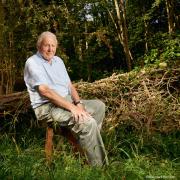The self-taught portrait painter with ambitions to paint HRH The Queen
I am fresh from a second reading of Martin Gayford’s fascinating book, Man with the Blue Scarf, about sitting for the artist Lucian Freud. I read it again after setting up my meeting with a talented portraiture artist Matthew Penn as I wanted to ensure that I could successfully delve into his work.
With the images of Matthew’s artistry in my head, I sit in the café at the Hornby Factory between Matthew’s home town of Ramsgate and his newly refurbished studio in Margate.
The May sunlight hits the side of my face, illuminating the reason Matthew paints. He loves strong lighting, explaining: “I like the contrast between one side of the face being brightly lit and the other almost disappearing, to make the viewer curious.
“I want the viewer to feel they can climb into that dark space and look and explore and find what that part of the face feels like to the touch.”
Matthew Penn is a Kent boy born and bred. He left his secondary school in Canterbury under a bit of a cloud, if the criticisms of his teachers are to be believed.
However, despite being told he would ‘never achieve anything’, Matthew is now a self-taught artist who can command a good sum for his portraits and has been able, unlike many artists, to earn his living exclusively from his art.
Portraits are a major part of any artist’s repertoire and many develop their own style to accommodate their skills.
Matthew takes the sitter into account when he decides on a painting, often choosing random faces and taking two months to complete each piece.
He appreciates that not all models can sit down for hours on end so he breaks the monotonous rigidity by sketching for an hour, having already prepared his 4ft by 6ft aluminium canvas, a more durable material. Then he will take up to 500 photos.
“I start with quick washes of acrylic then slowly make the marks smaller and smaller and when I get to the oil paint, I can use tiny marks which give the structure of the face,” he says. “I am most interested in how skin covers the structure of the face.
When the paint is dry, I add glazes and scumble – the use of a lot of white spirit in the oil paint so that it can be rubbed in. It allows each layer to shine, which gives the same impression as people’s skin, which tends to change colour.
“There is a sense that the skin is breathing and alive, done with small marks that represent each section of skin. It is also like growing the person’s emotions in, through each layer.”
Matthew says the laborious photoshoots and the intricate technique is all worth it in the final product. “I want to portray the side that the sitter knows, not the one the public sees. It is all about finding the inner depths of the character in front of me.
“I don’t want the sitter to look bored; I’m looking for that quick moment they let the emotion out.”
It is standard practise in the creative community for the artist to dictate to the sitter or model how they want them to pose, but Matthew’s philosophy takes on a darker tone. He encourages sitters to reflect on their lives, and eventually two or three photographs will succeed in bringing out these inner and often melancholic depths.
This is principally in the eyes, which are a fundamental feature of the portrait. “It is the bad things in life that people keep hidden. I don’t believe people in portraits need to be portrayed as their character, because people put on a front,” he says.
Matthew wants to capture the pure essence of the sitter, to absorb them into the canvas, show them for who they really are. That can’t be done in mere seconds. It takes careful planning and time is certainly nothing Matthew worries about. He works 12 hours a day for seven days a week.
Since working in oils, he tends to work on a group of portraits as there is a longer drying time than acrylic. He doesn’t want to paint more than 10 or 12 portraits a year.
Not remotely put off by the adverse comments of his teachers, Matthew now tells me that he would like to paint HRH The Queen: “I think I would do Her Majesty justice, I am confident of that.”
Meanwhile, Matthew is tremendously excited about the potential in Margate, where he has just moved, and the efforts to create an artistic hub in this south coast town, not least with the nearby Turner Contemporary, just five minutes from his studio – which is definitely worth a visit.



























